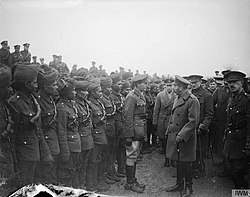British Indian Army
The British Indian Army, officially called simply the Indian Army (IA), was the army in British India during British rule (1858–1947).[1][2][3] The Indian Army served as a security force in India itself and fought in battles overseas, particularly during the two World Wars.
The term "Indian Army" was used to describe the presidency armies, especially after the Indian Mutiny. However, the first army officially called the "Indian Army" was raised by the government of India in 1895. In 1903 the Indian Army absorbed the three presidency armies (the Bengal Army, the Madras Army and the Bombay Army).
Between 1903 and 1947 the Army of India consisted of two separate parts: the Indian Army and the British Army in India. The first consisted of Indian Army regiments from India, while the second were British Army regiments from the United Kingdom which were sent to India.
The Army of India defeated the Ottoman Empire and conquered Iraq in the Mesopotamian Campaign of World War I.
Organization
The Indian Army was formed after the Indian Rebellion of 1857 when the government of Britain took over rule from the British East India Company. Before that the company had their own army units, paid for by their profits and these joined with British Army units.
The army of the British East India Company recruited mostly Muslims in the Bengal Presidency (which consisted of Bengal, Bihar and Uttar Pradesh), and high caste Hindus mainly from the rural plains of Oudh. These troops rebelled against the British in 1857.
After the rebellion, the British started recruiting what the British called the "martial races," particularly Punjabi Muslims, Marathas, Rajputs, Sikhs, Gurkhas, Pashtuns, Garhwalis, Mohyals, and Dogras.
After World War II
After World War II, the British formations and units that had been part of the British Army of India were divided between India and Pakistan.
Soon after the Partition of India, both the newly formed armies fought each other in the First Kashmir War from 1947 - '48 which begun the bitter rivalry that has continued into the 21st century.
British Indian Army Media
The Corps of Guides, painted by Richard Simkin, published 1891.
No. 2 Company of the Bombay Sappers and Miners during the Boxer Rebellion, China, 1900.
Indian Army soldiers, including men from the 3rd Sikh regiment and 1st Sikh Infantry, Punjab Frontier Force, in Beijing, c. 1900.
117th Mahrattas at a fort in the North West Frontier, India, 1909
Flag party of the 52nd Sikhs (Frontier Force) at Kohat, with their regimental colours in 1905
Soldiers of the 3rd Sappers and Miners. Illustration by Maj. A. C. Lovett, published 1911.
Officer of the 15th Lancers (Cureton's Multanis), painted by Maj. A. C. Lovett. The regiment served in France during the 1914 Winter Operations.
King George V inspects Indian troops attached to the Royal Garrison Artillery at Le Cateau, 2 December 1918
References
- ↑ Peter Duckers The British Indian Army 1860-1914. Shire Books, ISBN 978-0-7478-0550-2
- ↑ Indian Army: History Archived 2006-11-16 at the Wayback Machine "the total strength of the British-Indian Army was 90,000"
- ↑ Brig (Retd) Noor A Husain The Role of Muslims Martial Races of Today's Pakistan in British-Indian Army in World War-II Archived 2005-09-01 at the Wayback Machine










